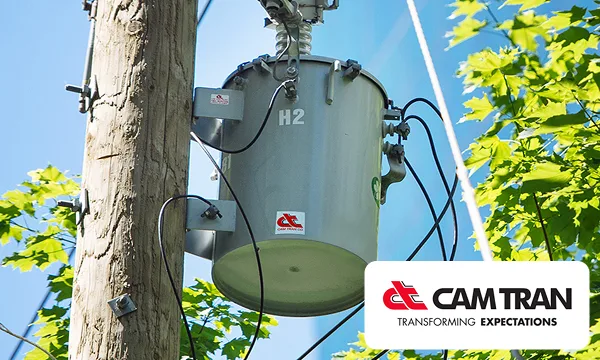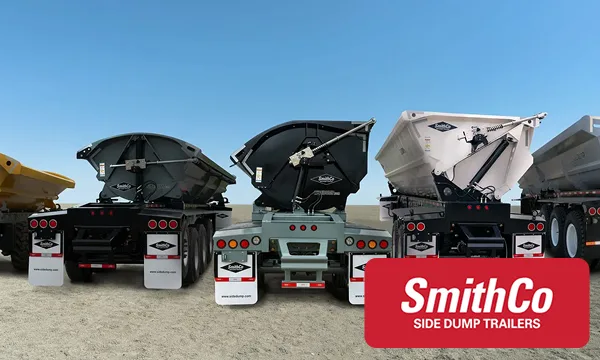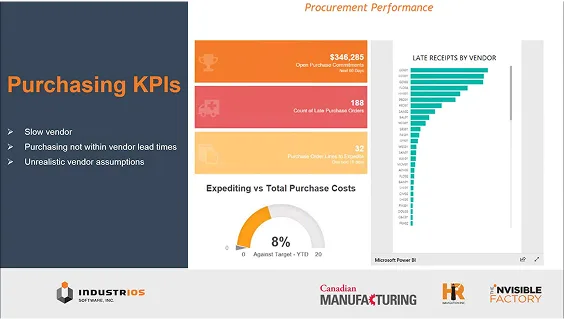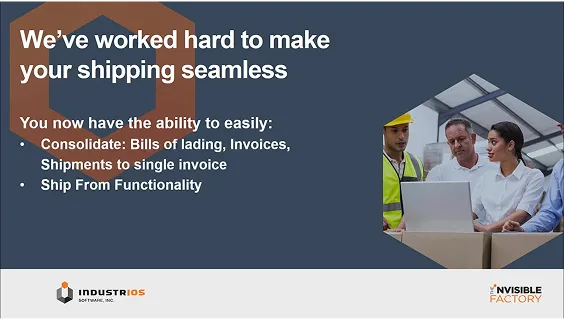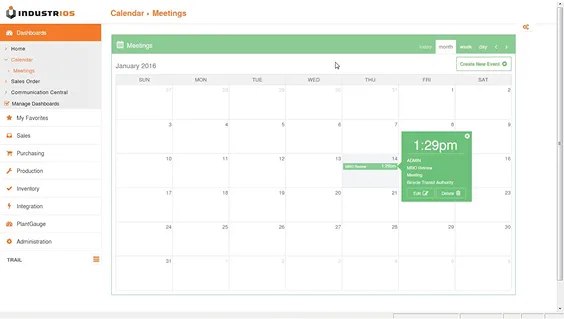The Finished Goods January 2018
Welcome to the first issue of The Finished Goods, the INDUSTRIOS monthly newsletter that highlights tips and features to help you get the most out of INDUSTRIOS.

In This Issue
| System Admin | Adding a User Title and Signature to Reports/Forms |
| Sales Order Fulfillment | How to Consolidate Shipments |
| Material Planning | How to Flag A Requisition as Reviewed |
| Inventory Control | Add Saved Ranges to the Inventory Activity Query |
| Production Control | Re-open a Job for Correction |
How to Add a User Title and Signature to Custom Reports 

A User signature and Title can be stored for INDUSTRIOS Users and included on custom forms used in INDUSTRIOS. The key benefit is that multiple versions of the same report or form are no longer required to accommodate different signatures.
Follow these steps to add a User Signature and Title
1. Before you start, you will need an image of the signature saved as a JPG or PNG file.
2. Navigate to Administration | System Administration | Security |User
3. Select Modify an existing user
4. Select the relevant User from the list and click Next
5. In the User Signature area, locate the signature image file; select it and then click Open
6. The image will appear in the User Signature space.
7. The image cannot be modified in INDUSTRIOS. If cropping is required, please modify the original image and reload.
8. To remove an image in preparation of loading another, click the Reset button.
9. Add a User Title which will appear below the signature
10. Click Next to advance through the wizard and click Finish to complete the adding of the signature.
11. The signature is now available for inclusion on customized forms.
12. ?? Where is field stored and how would it get added to a crystal report. Need finished example.
How to Consolidate Shipments 
Does your carrier or customer require a consolidated Bill of Lading for multiple shipments? Here’s how to quickly consolidate/unconsolidate shipments.
Before you start: Consolidations can be created automtatically when you create shipments within INDUSTRIOS. If the shipments already exist, they can be manually consolidated.
- Navigate to Sales | Sales Order Fulfillment | Transaction Processing | Shipping Requirements – Sales Order
- Tag the orders needing shipments
- Click the Create Shipment button; update the committed quantities and then click Create to launch the Create Shipment wizard.
- Select the Consolidate Bill of Lading checkbox
- Choose the Primary Basis for Consolidation (Customer, Customer.Ship To, or Sales Order Number). If necessary, you can select a secondary basis for consolidation.
- Click Process. Any shipments that meet the criteria will be consolidated.
- If shipments have already been created they can be consolidated manually.
- Click the Update button on the Shipment Workbench and select Consolidate Bill of Lading.
- Identify which shipment should be the master shipment. The master shipment will be updated with the lines from the other shipments tagged for consolidation.
- The same Primary and Secondary bases for consolidation that were available for automatic consolidation are available when manually consolidatiing shipments.
- Click Process to run the consolidation process.
How to Flag a Requisition as Reviewed 


The ability to flag a requisition as Reviewed will be of interest to Material Panners who like to work in the following way:
- MRP runs frequently and you would like to earmark specific requisitions to prevent deletion by MRP. Any requisition flagged as Reviewed will not be deleted by the next MRP run.
- Your workbench is orgainzed to easily view only those requisitions still requiring review. The Review status appears on the Workbench Range function. You can easily filter on “Not Yet Reviewed” to see only those requisitions requiring your attention.
- Requisitions are considered for action only after they’ve been reviewed. The Range feature can be used to filter on those requisitions that have been reviewed.
Bear in mind that if the requisition was created manually, the related job’s status must may impact your ability to flag a requisition as reviewed. Purchasing Application Settings 020 and 021 set the required job status to allow material and direct purchases. A System generated job must be of a Planned (b1) status or higher before a linked requisition can be set to Reviewed.
How to Re-Open and Correct a Job 


We’ve been there. You have closed or canceled a production job and then you realize:
- You closed the wrong job
- There are missing time or materials transactions
- Too much time or material was recorded for the job
- The job was closed for too a too few quantity
Have no fear. Follow the procedure below to easily re-open and correct the job. This process ensures that inventory values and cost adjustments are processed appropriately. Please note that the ability to re-open closed jobs is controlled by a User’s security.
- Navigate to Production Control | Job Entry Browse
- Locate and tag the job you wish to re-open
- Click on the Set Status button and then select “Re-open Closed/Cancelled Job” from the Options list and click Next.
- Click Process to re-open all tagged jobs
- The job’s status reverts to Partial Complete
- Process any required transactions to correct time and materails tracked to the job.
- Re-close the job. If the total close quantity hasn’t changed, process the Full Close with a quantity of zero. If the initial close quantity was too hgh, process a negative quantity adjustment via the Job Close/Cancel screen before processing a Full Close for the job.
Saved Ranges on the Inventory Activity Query
The Inventory Activity Query is a key tool used for quick visibility to summarized and detailed activities for inventory items. The Saved Range functionality enhances the feature, allowing you to pre-define a consistent view of items. Typical scenarios include:
- By Planner ID
- By Inventory Location
- Buy versus Make Items
Here’s How to Create a Saved Range
- Click on the Range button in the upper right portion of the screen. The Range name displayed is the last range used. If you are creating a Saved Range for the first time, the Range will be called All Records.
- Saved Ranges can be created as Public Views (visible to everyone with access to the Query) or a Private View which will only show in your lsit of Saved Ranges.
- Click the Private Views Tab and then click the New button
- Assign a name to the View. The name should be descriptiive enough to easily identify the View e.g. All Make Item
- Click the Range button and enter selection criteria on the Standard Fields Tab and/or the Classification Tab. The more selection criteria you enter, the narrrower your search.
- Click OK to save the Range. Notice that the name on the Range button is now the Range that you just added.
- To select a different Range, click on the Range button and choose from either the Public or Private views. You can also modify existing Ranges,
We hope that you found this issue of The Finished Goods helpful and informative. To send us some feedback or request topics for future issues, please send an email to finishegoods@industrios.com



